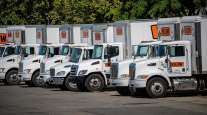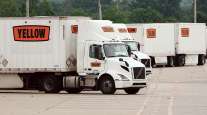Trucking Failures Decline
This story appears in the May 7 print edition of Transport Topics.
Truck fleet failures continued to decline early this year, despite high diesel prices that stubbornly remained above $4 per gallon, according to a new report.
Carrier failures fell in the first quarter because viable fleets have managed cargo capacity effectively and high used-truck prices allowed marginal operators to sell out instead of simply shutting down, according to the report by Avondale Partners analyst Donald Broughton.
The report, provided to Transport Topics last week, showed that 160 carriers failed in the first quarter, down from 295 in the first quarter of last year. About 2,110 trucks were subtracted from the nation’s fleet in the first quarter as a result of those closings, almost 50% fewer than the 3,955 in the 2011 period.
The level of failures peaked at 970 in the second quarter of 2008, when diesel prices on average also hit a record at $4.427 per gallon. The link between diesel prices and failures began to uncouple last year, when failures dropped in the first quarter of 2011, even as diesel rose more than 45 cents per gallon. Retail diesel cost an average of $4.073 a gallon last week.
That new trend accelerated in 2012 as the number of fleets closing down fell by 135, even though diesel was 37 cents more expensive per gallon on a year-over-year basis.
“We are witnessing a time when very few companies are exiting the truckload sector via bankruptcy,” Broughton said. “For those companies looking to cease operations, the extremely strong used-equipment market is allowing them to make a far more graceful (profitable) exit.”
Used truck prices now are more than 30% higher than they were four years ago and 17% above last year, according to a report from the National Automobile Dealers Association and American Truck Dealers.
At the same time, Broughton noted, industry capacity has been reduced by 325,000 trucks, or about 18%, since 2008, which has brought supply and demand into balance and fostered higher earnings in the truckload sector.
“In the first and second quarters of 2011, many thought rising fuel prices would drive several companies out of business,” Broughton said in his latest report.
“The simple reason for the lack of failures is this — if a company was well-enough capitalized and operated to make it through . . . challenges of the 2006-2010 time frame, then that company should be able to survive,” he wrote. “This continues to hold true in the current high-fuel price environment.”
Another reason for the drop-off in failures, Broughton said, was the fact the wide swings in diesel prices have moderated and brought more order to fleets’ fuel surcharge collection process.
“When big swings in a line item as significant as fuel happen, it plays havoc with a trucking company’s financials,” multiplying the effects of fleets’ immediate payments for fuel and subsequent fuel surcharge collections, he said.
During the first quarter of this year, for example, the spread between the high and low diesel prices was 37.5 cents, according to U.S. Energy Department statistics. In the first quarter last year, the range was about 60 cents.
Bob Costello, chief economist for American Trucking Associations, also said more-effective fuel surcharge management can help explain the drop-off in failures.
Richard Mikes, a principal at Transport Capital Partners, a merger and acquisition firm, said that increased fuel surcharge management is helping fleets to improve their financial performance and cut down on failures.
“There has been more focus on fuel surcharges,” Mikes said. “There is a more favorable environment now. When capacity is tight as it is now, shippers have been more willing to pay the surcharges.”
Costello said he believes bankruptcies soon could begin to increase again because of financial pressures.
“Many small fleets are in a difficult situation,” he said. “They are having trouble managing their tractors.”
“Replacing tractors has become much more expensive for them,” Costello said. “New equipment is more expensive, and they have much older equipment to trade. Thus, they have to finance more than they used to, and if they keep the equipment, their maintenance costs rise.”
Broughton’s report also noted the effect of those pressures on capacity.
“Smaller, less well-capitalized carriers needing to refresh their fleets are finding that, due to higher new equipment prices, they have to trade in more used trucks per new truck purchased.”
He said, however, that his report doesn’t include the effect on capacity when a carrier buys another one for the drivers and equipment and then retires between 10% and 20% of the trucks or doesn’t hire the acquired company’s drivers.
Fleets often focus on drivers that come along with older equipment, Broughton said.
One example he cited was the recent purchases by Celadon Group of assets from Frozen Food Express and YRC Worldwide, as well as smaller companies such as Teton Transportation.
Those moves enabled Celadon to add 218 drivers and boost its capacity, but overall equipment capacity was reduced because the number of trucks sold was far larger than the number of new trucks those drivers are running for Celadon.




